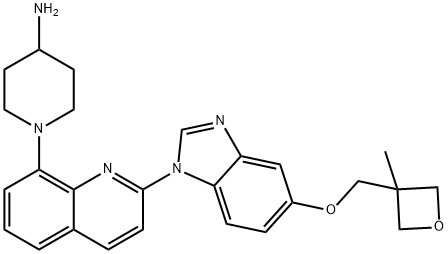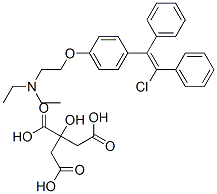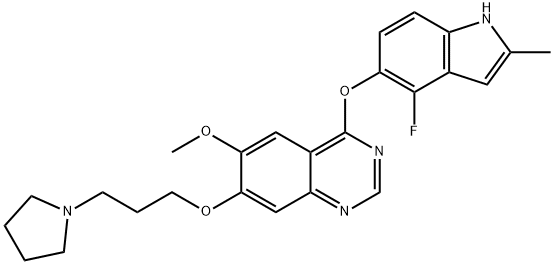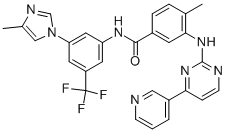Linifanib (ABT-869)
- CAS NO.:796967-16-3
- Empirical Formula: C21H18FN5O
- Molecular Weight: 375.4
- MDL number: MFCD11840918
- SAFETY DATA SHEET (SDS)
- Update Date: 2024-11-19 15:53:33
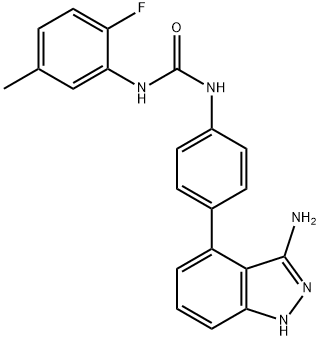
What is Linifanib (ABT-869)?
Chemical properties
Beige Solid
The Uses of Linifanib (ABT-869)
Linifanib (ABT-869) is a novel, potent ATP-competitive RTK inhibitor for KDR, CSF-1R, Flt-1, Flt-3 and PDGFRβ with IC50 of 4 nM, 3 nM, 3 nM, 3 nM, and 66 nM respectively.
The Uses of Linifanib (ABT-869)
Linifanib (ABT 869) is an oral tyrosine kinase inhibitor with antineoplasic activity. As a dual inhibitor, Linifanib, is being tested on several different cancers.
What are the applications of Application
ABT-869 is a VEGF (Flk/Flt) and PDGFR inhibitor
Definition
ChEBI: A member of the class of ureas that is urea in which one of the nitrogens is substituted by a 2-fluoro-5-methylphenyl group, while the other nitrogen is substituted by a p-(3-amino-1H-indazol-4-yl)phenyl group. It is a poten , selective inhibitor of vascular endothelial growth factor and platelet-derived growth factor receptor tyrosine kinases.
Biological Activity
linifanib (abt-869) is an effective atp-competitive tyrosine kinase inhibitor against the platelet-derived growth factor (pdgf) receptor and the vascular endothelial growth factor receptor (vegfr) families, including constitutively active fms-like receptor tyrosine kinase 3 (flt3) [1][2]. it is of ic50 values of 0.55 nmol/l and 6 μmol/l to the cell growth in ba/f3 flt3 itd mutant cells and in ba/f3 flt3 wt cells, respectively [1].flt3 is important in controlling the proliferation and differentiation of hematopoietic cells. patients with acute myeloid leukemia (aml) showed activating mutations in flt3. these mutations caused abnormal cell proliferation [1].linifanib at a concentration of 10 nmol/l induced apoptosis in internal tandem duplication (itd) mutant cells, but showed no effect in wt cells. treatment with linifanib did not differentiate wt cells from flt3 mutant cells with mutation at d835v, in inhibiting proliferation or reducing cell viability. in ba/f3 flt3 itd cell lines, linifanib at a concentration of 10 nmol/l, effectively inhibited the phosphorylation of flt3. 10 nmol/l linifanib reduced the phosphorylation of akt at ser473 [1].daily orally treatment with linifanib by gavage in nod/scid mice with itd mutant cell decreased the leukemia progression rate compared with the control. on day 7, itd mutant cells showed rapid progression in control mice, whereas linifanib-treated mice showed no detectable disease. in addition, daily linifanib-treated mice with itd mutant cells showed significantly longer (p < 0.01) survival duration than control mice with itd mutant cells only [1].
storage
Store at -20°C
References
[1]. jenny e. hernandez-davies, joan p. zape, elliot m. landaw, et al. the multitargeted receptor tyrosine kinase inhibitor linifanib (abt-869) induces apoptosis through an akt and glycogen synthase kinase 3β–dependent pathway. mol. cancer ther., 2011, 10(6):949-59.
[2]. joyce e. ohm, michael r. shurin, clemens esche, et al. effect of vascular endothelial growth factor and flt3 ligand on dendritic cell generation in vivo. journal of immunology, 1999, 163:3260-3268.
Properties of Linifanib (ABT-869)
| Melting point: | 180-183°C (dec.) |
| Boiling point: | 542.2±50.0 °C(Predicted) |
| Density | 1.424 |
| storage temp. | -20°C Freezer |
| solubility | DMSO, Methanol |
| form | Brown powder. |
| pka | 13.30±0.70(Predicted) |
| color | Beige |
Safety information for Linifanib (ABT-869)
Computed Descriptors for Linifanib (ABT-869)
New Products
(S)-3-Aminobutanenitrile hydrochloride 4-Methylphenylacetic acid N-Boc-D-alaninol N-BOC-D/L-ALANINOL Tert-butyl bis(2-chloroethyl)carbamate 3-Morpholino-1-(4-nitrophenyl)-5,6-dihydropyridin- 2(1H)-one Furan-2,5-Dicarboxylic Acid Tropic acid 1-Bromo-3,5-Di-Tert-Butylbenzene S-2-CHLORO PROPIONIC ACID ETHYL ISOCYANOACETATE 2-Bromo-1,3-Bis(Dimethylamino)Trimethinium Hexafluorophosphate 4-IODO BENZOIC ACID 3-NITRO-2-METHYL ANILINE 1-(2,4-DICHLOROPHENYL) ETHANAMINE (2-Hydroxyphenyl)acetonitrile 4-Bromopyrazole 2-(Cyanocyclohexyl)acetic acid 4-methoxy-3,5-dinitropyridine 1-(4-(aminomethyl)benzyl)urea hydrochloride 2-aminopropyl benzoate hydrochloride diethyl 2-(2-((tertbutoxycarbonyl)amino) ethyl)malonate tert-butyl 4- (ureidomethyl)benzylcarbamate Ethyl-2-chloro((4-methoxyphenyl)hydrazono)acetateRelated products of tetrahydrofuran
You may like
-
 Linifanib >95% (HPLC) CAS 796967-16-3View Details
Linifanib >95% (HPLC) CAS 796967-16-3View Details
796967-16-3 -
 Linifanib 96% CAS 796967-16-3View Details
Linifanib 96% CAS 796967-16-3View Details
796967-16-3 -
 1975-50-4 98%View Details
1975-50-4 98%View Details
1975-50-4 -
 2-HYDROXY BENZYL ALCOHOL 98%View Details
2-HYDROXY BENZYL ALCOHOL 98%View Details
90-01-7 -
 2-Chloro-1,3-Bis(Dimethylamino)Trimethinium Hexafluorophosphate 221615-75-4 98%View Details
2-Chloro-1,3-Bis(Dimethylamino)Trimethinium Hexafluorophosphate 221615-75-4 98%View Details
221615-75-4 -
 61397-56-6 CIS BROMO BENZOATE 98%View Details
61397-56-6 CIS BROMO BENZOATE 98%View Details
61397-56-6 -
 14714-50-2 (2-Hydroxyphenyl)acetonitrile 98+View Details
14714-50-2 (2-Hydroxyphenyl)acetonitrile 98+View Details
14714-50-2 -
 118753-70-1 98+View Details
118753-70-1 98+View Details
118753-70-1
